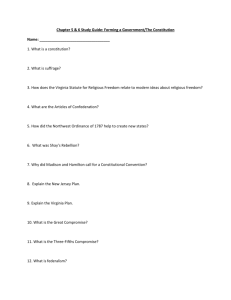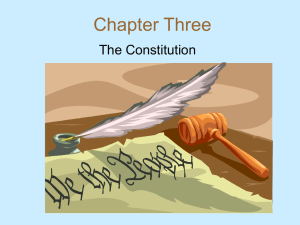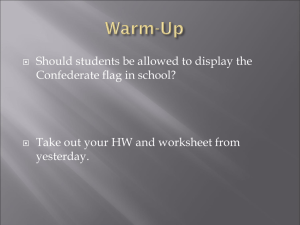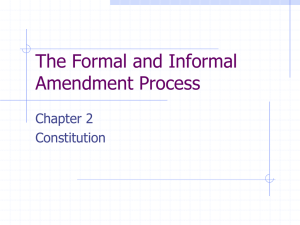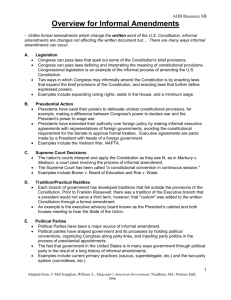The Constitution
advertisement
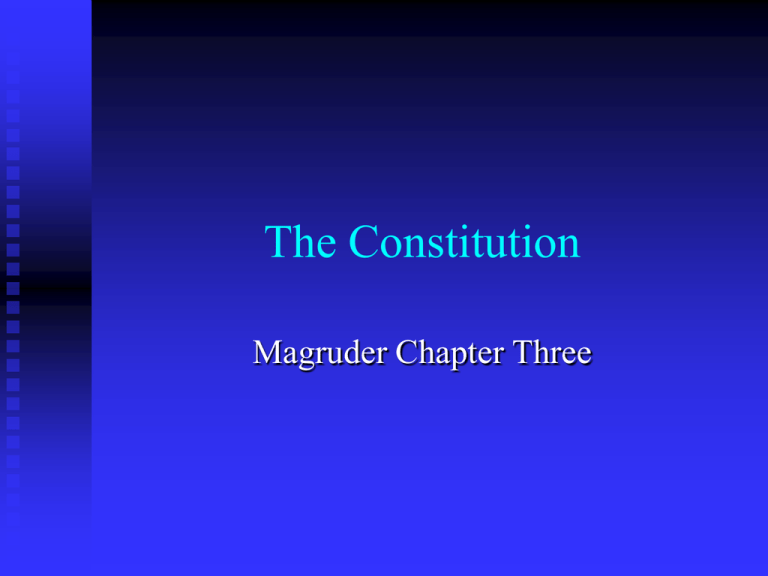
The Constitution Magruder Chapter Three The Six Basic Principles Section One Basic Principles Popular Sovereignty Government can govern only with the consent of the governed Sovereign people created the Constitution and the government Basic Principles Limited Government Government may do only those things that the people have given it the power to do The government and its officers are always subject to the law Basic Principles Separation of Powers The Constitution distributes the powers of the National government among Congress (legislative branch), the President (executive branch), and the courts (judicial branch). Basic Principles Separation of Powers (con) The Framers of the Constitution created a separation of powers in order to limit the powers of the government and to prevent tyranny—too much power in the hands of one person or a few people. Basic Principles Checks and Balances Each branch of government was subject to a number of constitutional restraints by the other branches. Veto power, judicial review, nomination and confirmation, etc. Basic Principles Checks and Balances (con) Although there have been instances of spectacular clashes between branches, usually the branches of government restrain themselves as they attempt to achieve their goals. Basic Principles Judicial Review Through the landmark case Marbury v. Madison (1803), the judicial branch possesses the power to determine the constitutionality of an action of the government. Basic Principles Judicial Review (con) In most cases the judiciary has supported the constitutionality of government acts; but in more than 130 cases, the courts have found congressional acts to be unconstitutional, and they have voided thousands of acts of States and local governments Basic Principles Federalism Federalism is the division of political power among a central government and several regional governments United States federalism originated in American rebellion against the edicts of a distant central government in England Basic Principles Federalism (con) Federalism is a compromise between a strict central government and a loose confederation, such as that provided for in the Articles of Confederation. Formally Amending the Constitution Section Two Formal Amendment Process First Method Amendment is proposed by Congress by a two-thirds vote in both houses, then ratified by three-fourths of the State legislatures. Formal Amendment Process Second Method Amendment is proposed by Congress by a two-thirds vote in both houses, then ratified by special conventions in threefourths of the States Formal Amendment Process Third Method Amendment is proposed at a national convention called by Congress when requested by two-thirds of the State legislatures, then ratified by three-fourths of the State legislatures. Formal Amendment Process Fourth Method Amendment is proposed at a national convention called by Congress when requested by two-thirds of the State legislatures, then ratified by special conventions held in three-fourths of the States. Formal Amendment Process Cannot amend the Constitution to changed a State’s representation in the Senate without that State’s consent. The 27 Amendments The first 10 amendments are called the Bill of Rights because they set out the great constitutional guarantees of freedoms for the American people. The 27 Amendments The Civil War Amendments (13th, 14th, and 15th) combined to end slavery, define citizenship, proclaim the rights to due process and equal protection of the law, and outlaw restrictions on the right to vote based on race, color, or previous condition of servitude. The 27 Amendments Other amendments further define the workings of government, empower the government in certain ways, or deal with important social issues. Informal Amendments Section Three Informal Amendments Basic Legislation Congress can pass laws that spell out some of the Constitution’s brief provisions Congress can pass laws defining and interpreting the meaning of constitutional provisions. Informal Amendments Executive Action Presidents have used their powers to delineate unclear constitutional provisions, for example, making a difference between Congress’s power to declare war and the President’s power to wage war. Informal Amendments Executive Action (con) Presidents have extended their authority over foreign policy by making informal executive agreements with representatives of foreign governments, avoiding the constitutional requirement for the Senate to approve formal treaties. Informal Amendments Court Decisions The nation’s courts interpret and apply the Constitution as they see fit, as in Marbury v. Madison. The Supreme Court has been called a “constitutional convention in continuous session.” Informal Amendments Party Practices Political parties have been a major source of informal amendments. Political parties have shaped government and its processes by holding political conventions, organizing Congress along party lines, and injecting party politics in the process of presidential appointments. Informal Amendments Custom Each branch of government has developed traditions that fall outside the provisions of the Constitution. An example is the executive advisory body known as the President’s cabinet.


